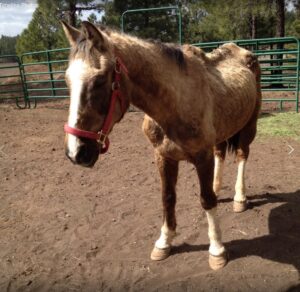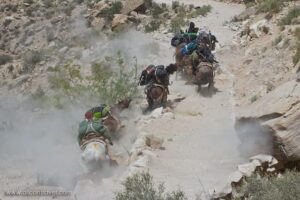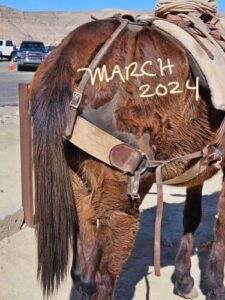In the spring of 2016, eight pack horses were transferred from the Havasupai Indian Reservation to Coconino Humane Association for care. The horses were severely malnourished and had bruises, open sores and infections. One was even missing an eye.
The horses were all confiscated from the reservation by the Bureau of Indian Affairs (BIA) for abuse or neglect.
The first four horses, seized in April 2016, belonged to tribe member Leland Joe, who was found guilty of cruel neglect and failure to provide necessary medical attention to his horses. At the time, activist Susan Ash said his horses “looked like skeletons.”
Since that spring, the Havasupai tribe has [reportedly] been working to change its policies on pack horses and increase its consequences for animal abuse.
The tribal court reported at least three animal abuse cases have ended in convictions in the past year.
RESERVATION CHANGES

In June 2016, the Havasupai Reservation temporarily banned commercial outfitters from running their popular tourist treks to the famous Grand Canyon waterfalls in order to revise their permit process.
Two months later, new outfitter license regulations were approved by the tribe. The new regulations specified that any pack animals must be inspected and permitted by the tribe’s animal control officer before trips. In addition, the packs placed on the horses must be no more than 130 pounds.
The tribe’s new regulations were initially questioned. For one, the Havasupai pack horses only need a body fat score of four out of nine, while a score of five or six out of nine is an optimum body fat score for horses.
At the time, Ash, who runs havasupaihorses.org, asked who would verify weight limits of packs the horses carry while out on the trail. She also wondered how they would know the horses were getting adequate water in the canyon, as there is no permanent water source out on the trail.
When these questions were directed to Abbie Fink, spokesperson for the tribe, she replied that while there are no animal control officers posted at the trailhead, the officers “monitor the bottom of the trail where it enters into Supai Village. The vast majority of the animals that are packed will pass through the village with their full-packs.” The officers can tell how much the horse has been packing by what’s on its back at the bottom of the trail, she said.
As for the lack of water, Fink said that “the tribe regularly hauls water in and fills the troughs.” She did not mention whether the water amount is checked by any officials who would have to make a trek to get there.
In September 2017, the tribe hired a prosecutor and judge for the Supai Village. Fink said this now makes “prosecuting animal abuse cases a top priority.”
Anyone in the tribe who has been found guilty of abuse is checked up on randomly by animal control, who thoroughly inspects their animals, she said.
If animals are found to be of ill care, they are placed in the impound lot on the reservation. “Impounded animals are cared for and at times even adopted out to other families who can better care for them,” Fink said.
OUTSIDE HELP

Photo Courtesy of HSUS
However, there are still no full-time vet services in Supai, with the closest one being over 40 miles away. Instead, the Humane Society comes in every few months and operates free clinics and vaccinations for residents’ horses, burros, dogs and cats.
The Humane Society has had a trio of three-day clinics in Supai since May 2017, with another one coming up next month. In total, 208 horses have been treated at the clinics, and four have been rescued. [Four. Out of the 208 still in possession of the tribe.]
Kellye Pinkleton, the director for the Arizona division, said that on the Humane Society’s most recent trip in March 2018, she noticed a “fairly sizable number of horses in impound.” While she was surprised at the large number at first, she said she realized it was a good sign, meaning the “animal control officers are going out and scanning” for horses that are in need of care.
Pinkleton also said that since the Humane Society’s first visit, there is now a “huge difference in willingness for tribal members to work with us in a collaborative way.” There was a hesitance to trust and receive outside help at first, Pinkleton said, perhaps due to the fact that tribe members were “certainly aware of the media reports” that negatively reflected on Havasupai horse owners.
Outside help was dire this past summer, when record floods washed over the Havasupai area July 11, turning the usually turquoise waters a murky brown. The reservation was forced to cancel hundreds of tourist trips to the falls through Sept. 1, losing large sums of revenue in the process. Lack of funds likely led to difficulty in horse owners being able to purchase the feed and hay they needed, Pinkleton said.
The bigger problem, however, was the fact that when the Havasupai Tribal Council closed the damaged trail to the remote village, it made it extremely difficult to bring in outside supplies. The Humane Society helicoptered nearly $5,000 of food and supplies to the tribe, including 320 bags of horse feed and 24 bales of hay.
While there is no doubt that the vaccinations, deworming, house calls, training and medical supplies are helpful for the Supai residents and their pets, only a handful of pack animals are brought to the clinics. While it hasn’t happened yet, Pinkleton said, it is possible that the animal control officers could cite the owners who bring in their horses for abuse if the situation calls for it.
NOW AND THEN

As recently as April 2018, Rob White of White Lily Films reported that during a trek to the falls with a companion, he “saw a downed horse whose wrangler kicked him in the face to get him back on his feet.”
White submitted an official witness statement to the BIA. In it, he detailed that the wrangler seemed frustrated when the horse wouldn’t get up after toppling over. White wrote that after other unsuccessful attempts of trying to get him up he “went up to the side of the horse, and gave the horse one swift kick on the bridge of its nose using the middle of the sole of his boot.”
White also said that he and his companion saw a few of the other horses “being whipped or forcefully yanked to keep them on the trail.”
White’s case did not go unnoticed by the BIA. “It’s my understanding that horse was rehabilitated by a private group and charges were sought against the wrangler,” he said.
As for the eight horses that were moved to the Coconino Humane Association in 2016, they have all since been adopted and have had over two years of rehabilitation.
Lakin Minic, administrative assistant at the Coconino Humane Association, fed and cared for the malnourished and bruised horses when they first arrived, and said they are now all in good shape.
Two horses went to rescues, and the other six went to private owners after extensive interviews. There was significant public interest in the horses, and the shelter received 12 serious candidates, Minic said. Some of the private horse owners have other abused horses and livestock that they rehab back to health. All but one of the horses are still in the northern Arizona region.
The exception is Pace, who now resides at Sunrise Horse Rescue in Calistoga, Calif. Originally, Pace was found by two sisters who were on a hike in Supai. One of the sisters said Pace’s bleeding and overall condition were one of the most horrific things she had ever seen.
When he first arrived, Pace had pneumonia, a large sore on his spine, bone fractures, skin infections and intestinal infections from severe malnourishment, said Jeff Hoelsken, executive director of Sunrise, in 2016.

Mary Taylor of Sunrise said Pace was still thin after three months of recovery. She added that he had a highly unusual hoof issue where “moisture caused his heel bulbs to peel and weaken.” The conditions of his hooves reflected the starvation he had experienced, Taylor said.
After a year of staying in a stall with dry bedding, his hooves heeled. After about eight months after Pace’s rescue, the horse then developed an abscess below his withers where his pack wounds had been, Taylor said. “The veterinarian stated that it probably was caused by a sliver of bone that had been broken off when carrying the packs,” she added.
But Pace has had a drastic comeback. Taylor said that “he loves to be groomed by the volunteers and although he still has some scars on his withers, their care has eased any discomfort that they cause.”
PACKING AGAIN
After being jailed briefly for animal abuse in 2016 and then imprisoned in 2017 for breaking his three-year probation, Supai member Leland Joe is currently working with horses in the packing industry again.
Fink wrote that “there was nothing stipulated in (Joe’s) federal sentencing that forbids him from working as a packer.” While she added that Joe is currently employed in the packing industry, she said none of his horses are being used for packing.
In April 2016, Joe was arrested and charged with two felonies and two misdemeanors related to cruel neglect and failure to provide necessary medical attention to one of his horses in Supai. After spending five days in jail, the felony charges were dismissed.
Joe originally received three years of supervised probation after his 2016 jail time, where he was prohibited from owning or caring for horses. However, in June 2017, his probation was terminated after a little over a year. The reason for the dismissal was that the court found Joe had violated his terms and conditions of the supervised probation, according to federal documents.
Instead, Joe was committed to the custody of the Bureau of Prisons for 120 days, with no supervised probation to follow. That means that after Joe’s release from prison in October 2017, he was allowed to work with horses and own them again. [An obvious prescription for disaster.]
However, some Supai residents have recently said Joe’s horses have what look like gash marks on them.
The four horses that Joe was arrested for neglecting in 2016 were hundreds of pounds underweight with sores along their spines, hip bones and shoulders. In court, Joe admitted that one of his horses had saddle sores for months before his arrest. He also attested that he had no horse feed on his property when the horses were taken.
“We are keeping a good eye on him,” said Supai animal control associate Darius Stewart. “We are observing him and he’s under investigation.”



